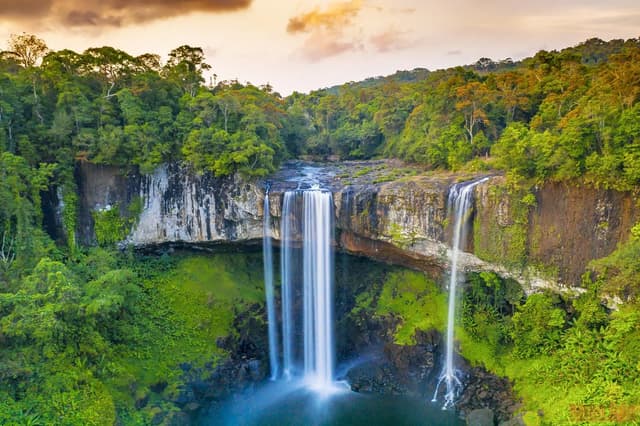Dry Season and Rainy Season in Vietnam
By Admin
05/10/2024
Explore the dry and wet seasons in Central and Southern Vietnam to plan your perfect trip
.webp)
1. Dry Season in Vietnam
In the central and southern regions, the dry season is the perfect time to explore the charm of Vietnam. You will be treated to stunning coastlines, rich culture and breathtaking natural landscapes, all in warm, sunny weather with little to no rain. Don’t miss out on the chance to create unforgettable memories during the dry season in Vietnam.
1.1. Dry Season Weather
- Hoi An, Hue and Da Nang: These cities experience hot and dry weather from mid-January to early August, with temperatures regularly around 30 degrees Celsius.
- Quy Nhon: About a six-hour drive south of Hoi An, Quy Nhon has a similar weather pattern, but the dry season here lasts a little longer.
- Nha Trang: The dry season lasts from January to September, with high temperatures and minimal rainfall.
- Southern Vietnam: The dry season starts in November and lasts until April or early May, with the period from late February to May being hot and humid. Average temperatures in the South range from 25 to 35 degrees Celsius year-round.
1.2. The Best Guide For Traveling During The Dry Season
- Reasons to Travel During the Dry Season
- Ideal weather: With dry and sunny weather, you can comfortably participate in outdoor activities without worrying about rain.
- Stunning scenery: The dry season brings vibrant scenery, from golden rice fields to clear blue beaches, creating great conditions for photography and exploration.
- Rich cultural activities: Many festivals and cultural events take place during the dry season, allowing you to fully experience the local culture.
- Reasonable prices: Although the dry season is peak tourist season, you can still find many attractive deals on accommodation and services.
- Characteristics of the Dry Season by Region
- North: The dry season lasts from October to March, with cool, dry weather. This is the ideal time to explore destinations like Hanoi, Sapa and Ha Long Bay.
- Central: The dry season in the central region lasts from January to August, with hot weather and little rain. Beaches like Da Nang, Hoi An and Nha Trang come alive and attract tourists.
- South: The dry season in the South starts in November and lasts until April or early May, with warm temperatures and little rain. This is the ideal time to explore major cities like Ho Chi Minh City and popular tourist destinations like Phu Quoc.
1.3. Travel Tips When Coming to Vietnam During the Dry Season
- What to Do?
- Explore the outdoors: Enjoy hiking, biking or taking nature tours.
- Participate in festivals: Plan to participate in cultural festivals that take place during the dry season to experience local customs.
- Enjoy the cuisine: Don't miss the opportunity to enjoy the specialties at local restaurants and eateries.
- Photography: The dry season is a great time for photography with beautiful natural light and stunning scenery.
- What to Bring?
- Comfortable clothing: Choose light, airy clothing that allows for easy movement in warm weather.
- Sunscreen: Protects your skin from the effects of the sun.
- Sneakers: For ease of walking and exploring the sights.
- Water: Always carry water with you to keep your body hydrated on hot days.
- Additional Notes for Your Trip
- Check the weather: Check the weather forecast before leaving to best prepare for your trip.
- Book in advance: If you plan to visit popular tourist attractions, book in advance to avoid disappointment.
- Plan your itinerary: Plan activities and destinations to optimize your time.
- Ask the locals for advice: They can give you useful information and suggestions about interesting destinations.
2. Rainy Season in Vietnam
The rainy season in Vietnam differs between the central and southern regions.
2.1. Rainy Season Weather
- Rainy Season in Central Vietnam
- Time: The rainy season usually occurs from August to November, with the possibility of being affected by typhoons.
- Weather: Predicting heavy rain and storms in coastal cities like Hoi An can be difficult. The rainy season usually tapers off in February, when temperatures are warmer and the sun is more abundant.
- Rainy Season in the South
- When: The rainy season lasts from June to November, although rain usually comes in short bursts and rarely disrupts travel plans.
- Pros: The rainy season can be a great time for photography, with the lush green rice fields and colorful fruit gardens of the Mekong Delta. However, from March to May, temperatures can reach 35-40 degrees Celsius, making it uncomfortable for some visitors.
2.2. The Best Guide For Traveling During Rainy Season
The rainy season in Vietnam can be a great time to explore the hidden beauty of the country. Here are some reasons and tips for your trip during the rainy season.
- Reasons to Travel During the Rainy Season
- Affordable Prices: Low season for tourism offers affordable prices on accommodation, transportation and entertainment.
- Better Service: Less number of visitors means you can expect better service.
- Cultural Experience: The rainy season is a great time to experience local culture, as some features become hidden in the crowd.
- Beautiful nature: Vietnamese nature in the rain has an irresistible charm.
- Characteristics of the Rainy Season by Region
- North (Hanoi, Ha Long, Sapa, Ninh Binh, Ha Giang): The rainy season starts in June, with heavy rains and dangerous trekking conditions.
- Central region (Da Nang, Hoi An, Hue, Nha Trang, Da Lat): The rainy season lasts from September to December, with the driest period from March to April.
- South (Ho Chi Minh City, Mekong Delta, Phu Quoc): The rainy season lasts from May to October, but the rain usually comes in short bursts.
2.3. Travel Tips When Coming to Vietnam During the Rainy Season
- What to Do?
- Visit museums and temples: Explore local culture while avoiding the rain.
- Shopping: Enjoy shopping at markets and stores.
- Enjoy the food: Enjoy local dishes on rainy days.
- Explore Coffee Shops: Enjoy Vietnamese coffee at local coffee shops.
- Visit an indoor amusement park: Find fun at indoor amusement parks.
- What to Bring?
- Hats and raincoats.
- Clothes dry easily.
- Waterproof sandals and sneakers.
- Waterproof backpack.
- Mosquito repellent and anti-itch cream.
- Additional Notes for Your Trip
- Research Vietnam weather by month before starting your vacation.
- Avoid visiting the islands during stormy weather.
- Mountain climbing can be very dangerous at this time.
- Avoid driving in heavy rain or at night.
- Plan a backup schedule in case the original schedule is affected by rain.
Vietnam Weather and Climate: A Guide to the Best Time to Visit
By Duc Anh
05/10/2024
Explore Vietnam's diverse weather and climate to plan the perfect trip
Dry Season and Rainy Season in Vietnam
By Duc Anh
05/10/2024
Explore the dry and wet seasons in Central and Southern Vietnam to plan your perfect trip
Detailed Guide to Vietnamese Currency for International Visitors - Updated December 2024
By Duc Anh
05/10/2024
Discover Vietnamese Dong and useful tips for your travel with iGuide.ai
Comprehensive Guide to Currency in Vietnam
By Duc Anh
13/11/2024
Discover the essentials of handling currency in Vietnam, from Money Exchange Tips to how to use ATMs, ensuring a shared financial experience during your visit


.webp)

